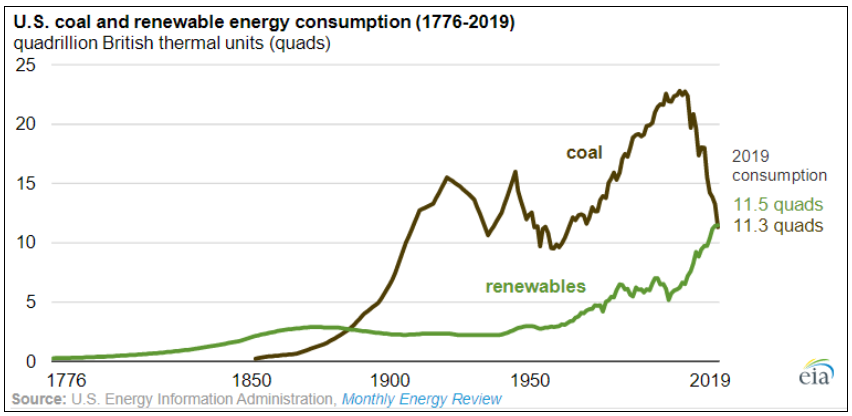Solar Energy is Dethroning Old King Coal
Solar power is now “the cheapest electricity in history,” according to new data from the International Energy Agency (IEA). On a cost-comparison basis, the economics of solar energy are superior to coal for new projects, and by midcentury (2025), solar could have a larger global energy footprint than coal.
This is a profound turning point, because coal has been a cost-effective energy source for thousands of years. There are Greek references to coal use in metalworking that date back to the fourth century B.C., and Roman Britons were heavy coal users by the second century A.D.
The transition to solar from coal should be a major net positive for human civilization. As useful as it has been, coal has also been awful for the environment, and the air humans breathe, since time immemorial.
For example, back in the late 13th century, King Edward I — commonly known as Edward the Longshanks — had to battle against Scotland on the one hand and rising coal use in London on the other. The king wanted to restrict London’s coal use on public health grounds, due to the acrid smoke that was poisoning the air and wrecked people’s lungs.
But King Edward lost the coal battle, even with strict bans and Draconian penalties enacted, because London was growing quickly, and Londoners desperately needed a low-cost fuel source for fuel and heat.
At the same time, the wood-based fuel supply from English forests was running out, with remaining forest acreage getting farther away from English cities as trees were chopped down. England’s scaled-up embrace of coal use, going far beyond what the Romans did, was in part a response to “peak wood.”
Coal also played a direct role in bringing about the Industrial Revolution.
In 1712, an inventor named Thomas Newcomen invented the atmospheric engine, commonly known as the Newcomen engine. The Newcomen engine was the world’s first steam engine to go into mass production, with hundreds of them built throughout the 18th century. The primary use case for the Newcomen engine was pumping water out of coal mines.
According to the World Coal Association, coal accounts for 38% of global electricity production.
As a cheap fuel source, it is still hard to beat coal in many emerging market countries, and coal is still used to meet large-scale electricity demand as renewable energy sources ramp up.
But the picture for coal is changing, fast, as a result of rapidly improving economics for solar and wind energy sources.
For example, in May 2020, U.S. renewable energy consumption surpassed U.S. coal consumption for the first time in more than 130 years, according to data from the U.S. Energy Information Administration (EIA).

As of 2019, according to EIA data, the U.S. used coal and renewable energy in equal amounts, with both contributing 11% to the total energy mix. But that 11% represents a rapidly falling percentage for coal, and a rapidly rising percentage for renewables.
This means the greening of America’s energy mix is no longer a hypothetical or a far-off possibility. It is happening here and now. The transition is accelerating, in part, because solar is now winning on the economics, and not just the external environmental benefits (better air quality, reduced carbon emissions, and so on).
The data on solar comes from the World Energy Outlook 2020, an annual report published by the International Energy Agency (IEA, not to be confused with America’s EIA).
According to new IEA calculations, the cost of capital for solar and wind development has fallen as much as 50% in the past two years alone, allowing solar energy to be produced at $20 per megawatt hour or even less. This has led the IEA to conclude that, for new energy projects with low-cost financing availability, solar photovoltaics have become “the cheapest source of electricity in history.”
The tipping point is related to energy economics. As the solar industry scales up in size, the cost of production goes down, thanks to the improved cost efficiencies of expanded output.
This is the same principle by which a mid-sized passenger car would cost hundreds of thousands of dollars, or possibly even millions of dollars, if produced in small-volume batches, but can sell for $30,000 or less at an output of millions of cars per year.
As a result of this transition — where the economics of solar now beat coal — the IEA anticipates solar overtaking coal as the world’s dominant electricity source as soon as 2025.
By the year 2030, according to further IEA projections, renewable energy could represent 80% of all new energy projects. And by 2040, the existing total output of wind and solar combined, including all legacy sources, is expected to be larger than total coal and gas output combined.
“I see solar becoming the new king of the world’s electricity markets,” says IEA executive director Fatih Birol. “Based on today’s policy settings, it’s on track to set new records for deployment every year after 2022.”
The Information Age, in which the global economy transitions from a physical emphasis to a virtual one, as software disrupts almost every industry, is also bringing about a historic energy transition.
As Sheikh Ahmed Zaki Yamani reportedly once said: “The Stone Age didn’t end for lack of stone, and the oil age will end long before the world runs out of oil.” He could have just as easily said coal.